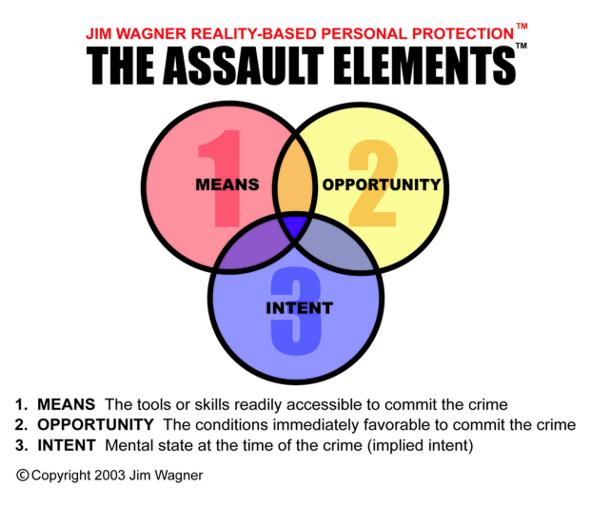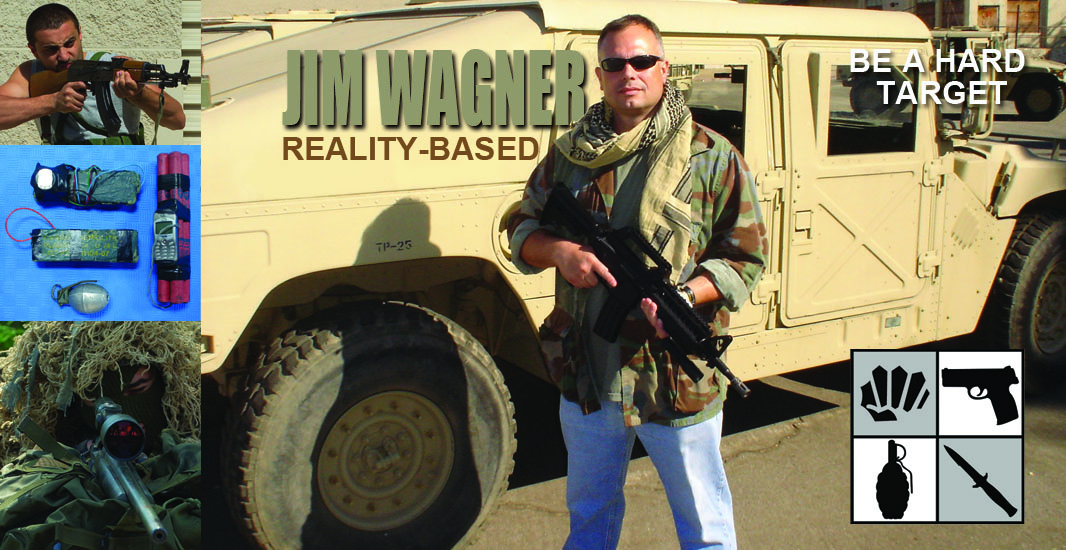In order to legally defend yourself, using physical force against a hostile person who you believe intends to do you harm, three elements must be present in order to justify your actions: means, opportunity and intent. If these three elements do not come together you may find yourself in the position of being the bad guy in the eyes of law enforcement and the judicial system.

Means
The aggressor must have the tools or skills readily accessible to commit the crime. If a drunken person tells you that he is “going to shoot everyone in the building,” but has no firearm, can you use lethal force against him? The answer is no. If the man has no weapon to carry out his threat then he does not have the means at that moment. Now, I definitely would call the police and report the incident because this guy may indeed be serious and go get a weapon and come back with one. On the other hand, if this same person says, “I’m going to shoot everyone in the building,” and he starts reaching into his coat pocket as if to get a weapon, then I would take necessary action. The act of reaching into the pocket after the threat demonstrates that he has the means to carry out his threat. Of course, anyone who displays a weapon in a hostile manner the means is obvious.
There does not have to be a weapon to determine means. If someone is empty handed, and they have threatened to beat me up, and I can see that they are physically fit enough to do it, then I can deduce that they have the means. Yet, if they are so drunk that I know that his uncoordinated strikes will do little damage to me, I cannot unload on him like I would a terrorist because the drunk simply does not have the means to effectively carry out his attack.
Opportunity
The aggressor must have the conditions immediately favorable to commit the crime. If a man threatens to beat me up, but he is in a wheel chair because he is a paraplegic, I cannot start pounding on him if all I have to do is walk to an area he cannot get to with his wheel chair. On the other hand, if we are in an elevator and he threatens to beat me up, I may have to push him away or strike him to make him stop. The close proximity gives him the immediate opportunity.
Someone may have the means and the intent to harm me, but they may lack the opportunity because of distance. If a disgruntled employee calls me up on the phone and tells me that they are going to kill me, and that they have a gun in their hand, I cannot grab my shotgun and drive over to his house and try to shoot him before he can shoot me. If the disgruntled employee where standing before me, with a gun, and telling me that he was going to kill me, then I have all three elements present and I can do whatever it takes to protect myself, even lethal force, in this case. However, for the personal calling me on the phone some distance away, the element of opportunity is lacking. Sure, I will take the threat seriously, but the correct procedure would be to call the police and report the incident. Such a threat comes under the heading of “terrorist threats” in most states in the United States.
Intent
Intent is the mental state of the aggressor at the time of the crime. Now, obviously we cannot know what a person is thinking. However, we can make an educated guess at what a person is thinking (implied intent) based upon the totality of circumstances. For example, if I am at an ATM machine (a money machine) withdrawing some money and a man walks up to me with a knife in his hand I can reasonable assume that he is about to rob me. With the knife in his hand I know that he has the means to do the crime of robbery (theft of money by force or fear), I know that he has the opportunity because I am at the ATM machine, which is often a point of robberies, and I can imply the intent of robbery because a normal person will not approach another at knife point while they are withdrawing money. Only a robber would do such a thing. On the other hand, if a man is across the street wandering around in a confused manner with a knife, I cannot assume he is about to do a robbery. He may be a mentally disturbed person, he may be in the process of committing a crime or has commit another crime, but because he is not approaching me I do not know his intent, therefore I cannot run across the street and use physical force on him and justify it by saying it was an attempted robbery.
One equals three
Imagine an off-duty police officer goes inside of his bank to make a transaction, and you didn’t know it was a police officer in civilian clothes. You then see a portion of his gun inside of his jacket as he leans to pick up a paper that he dropped, it would be very easy for you to assume that he was there to rob the bank. He has the means (the gun), and he has the opportunity (being inside a bank). However, if you were to suddenly jump him and injure him you would not be justified in your actions and the officer can have you arrested. Why? The reason is because the off-duty police officer did not have the intent to rob the bank or any of the customers. He was there legitimately. Such an incident is also likely if you are flying on a passenger aircraft and you see an armed passenger by chance. You have to ask yourself, “Is the person a Federal Air Marshal or a terrorist?” Being armed on an aircraft is definitely the means and the opportunity of terrorism, but the intent may not be there. Now, if the armed person jumps up from his seat and starts shooting passengers you have all three assault elements and can, and should, take action.
By knowing the assault elements by heart you will be able to articulate to the law enforcement officer that takes the report why you were justified in defending yourself. You will not be like the millions of martial arts practitioners who never delve into legal issues as part of their training and are left with the poorest of all answers, “Because I was taught that way.” Your skills, if ever used in a real situation, will lead you right into the hands of law enforcement and the court system, and these systems know all about the assault elements.
I have included a free download of the Jim Wagner Assault Cycle graph for your own personal use. You may use this copyrighted graph, as long as it is used in its entirety and no modifications are made to it, for teaching private lessons and group lessons within a legally recognized self-defense school.
Be A Hard Target.




